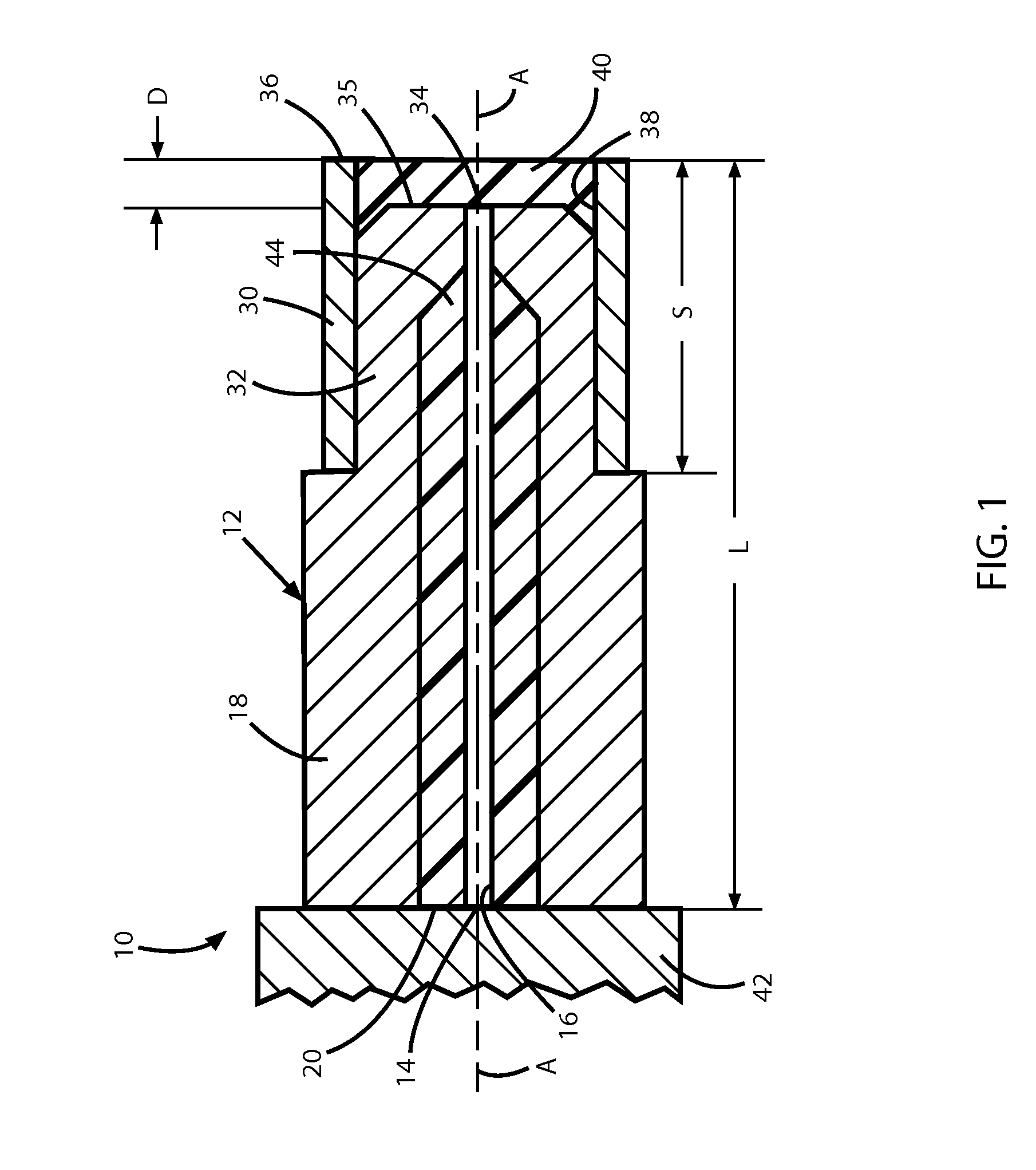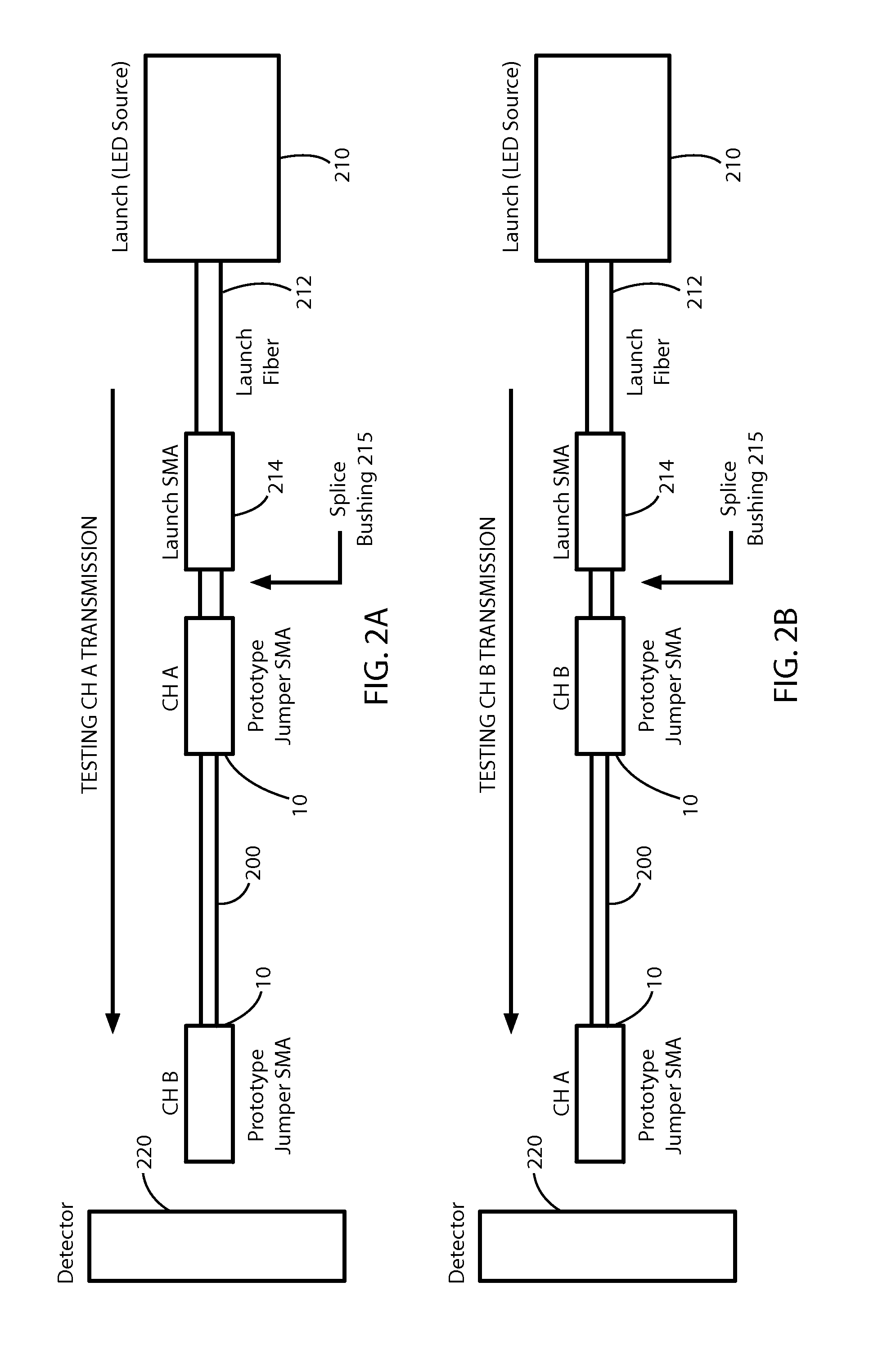Damage resistant fiber optic connector
a fiber optic connector, damage-resistant technology, applied in the direction of optical elements, instruments, manufacturing tools, etc., can solve the problems of exposed fiber endface damage, cap misplacement or inadvertently discarded, and the lack of means of most fiber optic connectors
- Summary
- Abstract
- Description
- Claims
- Application Information
AI Technical Summary
Benefits of technology
Problems solved by technology
Method used
Image
Examples
example one
[0023]FIGS. 2(a) and 2(b) show transmission test measurement set-ups for the inventive connector 10 in FIG. 1. An approximately one meter length of a 50 μm / 60 μm / 70 μm glass / glass / polyimide fiber 200 (available from, e.g., Polymicro) is terminated at each end by a connector 10 constructed according to the invention. For the purpose of each set-up, the exact length of the fiber 200 is not critical. The refractive index (RI) of the fiber core is 1.46, and the RI of the epoxy barrier 40 formed at the end of the ferrule tip 32 of the connector 10 (see FIG. 1) is 1.53. In FIGS. 2(a) and 2(b), CH A connotes one of the inventive connectors 10 at one end of the fiber 200, and CH B connotes the other connector 10 at the opposite end of the fiber.
[0024]The output of a LED light source 210 (e.g., WT&T Model LE-IG-C) is coupled to one end of a launch fiber 212, the other end of which terminates in a standard “launch” SMA connector 214. In FIG. 2(a), the CH A connector 10 at the right end of the...
example two
[0027]A second test was performed on a lensed version of the inventive connector 10. In FIG. 3, parts of connector 110 that correspond to those of the connector 10 in FIG. 1 have corresponding reference numerals increased by 100.
[0028]In this Example, the single fiber 200 in FIGS. 2(a) and 2(b) was terminated at one end with the inventive connector 110, and at the opposite end with a conventional type SMA 905 fiber optic connector. To prepare the connector 110, the ferrule nose of an existing SMA 905 connector having a 77 μm thru-hole ferrule passage 116 was modified by turning down the outside diameter of the ferrule tip 132 from 0.125 inch to 0.085 inch over a length of 0.125 inch from the leading front surface 135 of the tip. The rear portion of the ferrule 118 was then advanced into the connector body 142 until a shoulder length of 0.384 inch between the front surface 135 of the ferrule tip 132 and the connector body 142 was obtained.
[0029]One end of the fiber 200 fiber was inse...
PUM
| Property | Measurement | Unit |
|---|---|---|
| distance | aaaaa | aaaaa |
| length | aaaaa | aaaaa |
| thickness | aaaaa | aaaaa |
Abstract
Description
Claims
Application Information
 Login to View More
Login to View More - R&D
- Intellectual Property
- Life Sciences
- Materials
- Tech Scout
- Unparalleled Data Quality
- Higher Quality Content
- 60% Fewer Hallucinations
Browse by: Latest US Patents, China's latest patents, Technical Efficacy Thesaurus, Application Domain, Technology Topic, Popular Technical Reports.
© 2025 PatSnap. All rights reserved.Legal|Privacy policy|Modern Slavery Act Transparency Statement|Sitemap|About US| Contact US: help@patsnap.com



